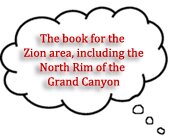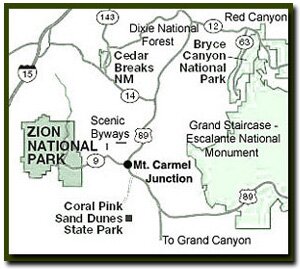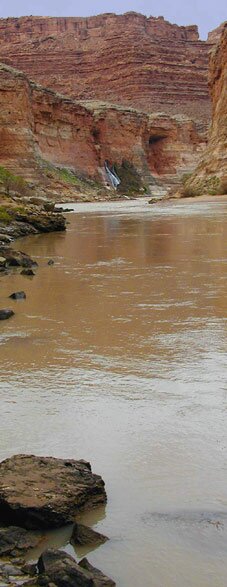 |
||||
|
Grand Canyon North Rim Toroweap Vacation Hike Backpack Rim2Rim Hwy-67 Photos Weather |
||||
Grand Canyon: South CanyonSouth Canyon is located in the far southern corner of Marble Canyon, about 35 miles (of the 277 mile long Grand Canyon) south of Lee's Ferry, which is the starting point of Grand Canyon National Park. Lee's Ferry is 15.3 miles down the river from the Glen Canyon Dam. Marble Canyon ends where the Colorado River meets the Little Colorado River.
Landmarks - There are paths following cairns on the ledge to the right to go around the first two large (15-20') waterfalls and another path to the left for the third waterfall. About 3 hours into the hike is the next obstacle. This one is larger. A 40' drop off, which is bypassed by taking the path to the right around it. This trail will end at the junction with an unnamed canyon. Past the unnamed canyon you will see a canyon on the left of the creek. This is Bedrock Canyon, located 4.3 miles from the trailhead. The rough water of the river near the South Canyon and Colorado River junction can be heard from this latter section of the wash. Gray Redwall Limestone Formation - About 1 mile past the Bedrock Canyon junction (note the gray rock) is an area difficult to navigate. The Redwall Limestone here is still the natural gray color. After passing below the formation, follow the cairns to the left, avoiding the narrows ahead and hiking up to the Redwall bench. Stay on this cairned trail to the junction of South Canyon and the Colorado River. You will get a couple of nice glimpses of the river from the top of the Redwall. The hiking is uphill at this point, most of it is along a dirt path. There is a narrow ledge (possible to hike over this) and some boulders to navigate. Descent to the Colorado River - Looking up river reveals a view of Vasey's Paradise and Marble Canyon. Follow the cairned path left, then back right, to a rockslide ravine of Supai boulders. Look for the remains of the Anasazi pit houses in this area. This is a steep down-climb that is rough on the knees after a full days hike with a heavy pack. Colorado River - The first matter of business is to choose a camp spot. The decent lands hikers onto a small beach that is quieter (due to the distance from the rough water) than the larger one down river, which is usually crowded with boaters in the summer. The smaller beach can become nearly water covered at certain times of the day. Be sure to explore the treasures that await down river: Stanton's Cave, Vasey's Paradise (1 mile) from the South Canyon and Colorado River junction), Marble Gorge Dam remnants and the Redwall Cavern. It takes about one hour to hike from Vasey's Paradise to the Redwall Cavern. Bushwhacking, bouldering and simple climbs are involved in this hike. Vasey's Paradise is the place to go and get water to filter, but watch for the poison ivy! Rather than traversing the slippery slope along the river, go to the large beach and in the back of it climb up the rockslide gully. There is a nice trail up top to Stanton's Cave. Optional Routes to Descend South Canyon Optional Short Cut - In our opinion this is the best way to do this route. This short cut is commonly known by the park service as the "UPS" route because quite often a man who happened to be a UPS driver would hike down to the river to go fishing. This hike is only 7 mile round-trip route allows hikers to visit the beaches at the mouth of South Canyon where it pours into the Colorado River, Stanton's Cave, and Vasey's Paradise. This is a great option for hikers that want to do this as a day hike, but be warned it is extremely strenuous for a one day hike. If you are wearing a big backpack then the traditional South Canyon trailhead near Buffalo Ranch might be the best option or be ready to do some pack hand-offs if you choose this short cut. The trail is steep, but the footing and handholds are very secure. Total Distance: 7 Miles Round Trip Take the same Buffalo Ranch road as described in the South Canyon driving directions, however after 11 miles of driving on the dirt road, and just .25 miles past the Cane Ranch intersection is another road that intersects from the left. After 5.25 miles the road passes the Buffalo Tanks and at 8.5 miles is an intersection. Turn right at the intersection and travel 1.4 miles to the rim and trailhead just above South Canyon. The Colorado River, South Canyon and a portion of Bedrock Canyon are visible from the parking area and trailhead. The descent is steep as it cuts through the cliffs. There should be many cairns which make the course easy to follow. You will see a promontory once you descend the talus filled wash and scramble down the ridge. The trail veers right and contours to the head of another talus drainage and long descent to the esplanade seen far below. From the esplanade another boulder and talus drainage is followed to arrive at the bottom of Bedrock Canyon 300 yards upstream from the confluence with South Canyon. Total descent from the trailhead to the intersection of Bedrock and South Canyons is about 1800' in 1 mile. It is 2.5 miles and another 600' of descent to arrive at Vasey's Paradise. Bedrock Canyon Route - This optional route to the Colorado River and Vasey's Paradise eliminates 2 miles of hiking one way, but the route finding, obstacles and difficulty encountered along the way might make it less preferable than the traditional entrance to South Canyon and Vasey's Paradise. The trailhead parking for Bedrock Canyon is 2.8 miles North-Northeast of the traditional South Canyon trailhead parking area. Hike south across the southern rim of Bedrock Canyon for .25 miles and look for the depression just below the rim that presents a small valley below. Hike into the valley and bear north as you traverse. Eventually cairns will lead down a very steep slope to the north and arrive at the Bedrock Canyon floor after almost 2000' of descent. Near the bottom there is one section in a slickrock pour-off that requires a careful downclimb of 15', but the deep, hue colored dry fall makes the going easy. Once in Bedrock Canyon travel is easy except for two major obstacles. The first is a narrow fluted passage that drops immediately 15' into an overhanging alcove. We were fortunate to find a 10' rope ladder hanging at this location. I would not count on this ladder being present however. Bring a 50' rope to insure safe descent and ascent. Just beyond this obstacle is another 25' pour-off into another alcove. Down canyon is a very tenuous 20' down-climb. Once again a 50' rope would have been a psychological bonus. From this point the travel down canyon to South Canyon was pretty uneventful. Upon Arriving at the junction of Bedrock Canyon and South Canyon it is a relatively passive 2.5 miles to the Vasey's Paradise beach area. Vasey's Paradise - Vasey's Paradise as described by John Wesley Powell: "On coming nearer we find fountains bursting from the rock high overhead, and the spray in the sunshine forms the gems which bedeck the wall. The rocks below the fountain are covered with mosses and ferns and many beautiful flowering plants. We name it Vasey's Paradise, in honor of the botanist who traveled with us last year." Note the flora at Vasey's: Poison ivy, columbine, monkey flower and watercress. (mile 33 on the river)
The Grand Canyon holds wonders like Vasey's Paradise, but beware of the poison ivy and be careful not to trample the vegetation and the endangered snail that lives around the waterfall. Water can be filtered from the bottom of the falls near the river. Stanton's CaveStanton's Cave, a large solution cave about 160' above the river, is now barred protecting a place where ancient treasures were found. Townsend's big-eared bats also find protection from humans behind the bars. Over seventy-four 4,000 year old split twig figurines, shells and beads, as well as 10,000 year old remains from giant California Condors and mountain goats were found. The cave got it's name when the survivors of the Brown - Stanton expedition stashed gear in the cave. Marble Gorge DamThe "man made caves" can be explored. They were test drill sites, made in 1964 for the proposed Marble Gorge Dam. A compromise occurred and as a result the Marble Gorge Dam and Bridge Canyon Dam were not constructed, but the plans to build the Glen Canyon Dam continued. Redwall CavernThe Redwall Cavern, an erosive river cave, was first seen by John Wesley Powell. (mile 34 on the river) Camping on the River There are two nice beaches for camping. When descending to the Colorado River the first beach is farther from the rough water and thus quieter. The problem with this beach is that the water from South Canyon (if it is running) as well as water from the river will cover the beach. If boaters are on the larger beach, this smaller area is a nice option. The larger beach slopes towards the back making the front area by the trees the best area for setting up a tent. The rocks near the back of the site are ideal for hanging food. Just knot the rope and slide it in the crack of the rock. This is the area where the trail is accessed to Stanton's Cave.
Best Trail Features: Vasey's Paradise is the goal for most hikers. The cascading fall is a spectacular display of water spurting from at least two caves in the mountainside. The Colorado River and the canyon, although perhaps seen before, is a special sight in this little piece of paradise.
Grand Canyon North Rim, ArizonaHistory of the Thunderbird |
East Zion Lodge Mileage from Stay in the heart of the parks, Mount Carmel Junction, and visit the treasures of the Southwest and Utah. Site Map Grand Canyon North Rim Grand Canyon Information Ranger Programs North Rim Trails Grand Canyon Maps |
||||||||||||||||||
|
This is my new favorite quote:
"I don't know who Mary Cisneros is, but I mean zionnational-park.com It's a better site than the NPS's anyway." Written by the authors of the book: Favorite Hikes in and around Zion National Park Contact Mary to report errors: |
|||||||||||||||||||
|
Zion History |
|---|
All rights reserved © Copyright Zion National-Park dot com
Do not use text, photos or maps without permission © Zion National-Park dot com
Contact the Author Mary Cisneros


 Traditional Route - From Fredonia, Arizona, proceed on highway 89A, bypassing the turnoff on highway 67 to the North Rim of the Grand Canyon. Turn right between mile posts 559 and 560. This is House Rock Buffalo Ranch Road. The graded dirt road is 22 miles/35.4km long. There is a brochure box at the entrance that often has information on the ranch and the California Condors that were released in this area at the Vermillion Cliffs. Follow the main dirt road for 19 miles/30.6km to the junction with USFS road 632. Turn left on road 632. This road is usually passable with a 2WD, but after rains or snow, the road can become difficult even with a 4WD. The flat strip of land to the left is a primitive airstrip. Turn right at the end of the airstrip and follow the rough road a little more than a mile to the South Canyon rim. The first .77 miles (measured as the crow flies, so its more like 1 mile) is a steep descent. It is 1,140' from the rim to the canyon floor below. Locate the sign for the trailhead and the cairn marking the location, to begin the down-climb. Be careful to keep site of the cairns on the route. Do not stray from the cairn defined route to the social trails. The start of the hike is an easy to navigate chute, followed by a series of steep switchbacks, with a few short down-climbs over and between fallen boulders. If wearing a large backpack, the down-climbs can be difficult. A flat outcropping of Toroweap limestone forms a large shelf about two-thirds of the way down. A well beaten dirt path traverses (2 dirt paths here one steeper than the other) the outcropping of limestone leading to a slickrock break. Follow the cairns and foot path down the cliff-side to the final set of switchbacks descending to the canyon floor.
Traditional Route - From Fredonia, Arizona, proceed on highway 89A, bypassing the turnoff on highway 67 to the North Rim of the Grand Canyon. Turn right between mile posts 559 and 560. This is House Rock Buffalo Ranch Road. The graded dirt road is 22 miles/35.4km long. There is a brochure box at the entrance that often has information on the ranch and the California Condors that were released in this area at the Vermillion Cliffs. Follow the main dirt road for 19 miles/30.6km to the junction with USFS road 632. Turn left on road 632. This road is usually passable with a 2WD, but after rains or snow, the road can become difficult even with a 4WD. The flat strip of land to the left is a primitive airstrip. Turn right at the end of the airstrip and follow the rough road a little more than a mile to the South Canyon rim. The first .77 miles (measured as the crow flies, so its more like 1 mile) is a steep descent. It is 1,140' from the rim to the canyon floor below. Locate the sign for the trailhead and the cairn marking the location, to begin the down-climb. Be careful to keep site of the cairns on the route. Do not stray from the cairn defined route to the social trails. The start of the hike is an easy to navigate chute, followed by a series of steep switchbacks, with a few short down-climbs over and between fallen boulders. If wearing a large backpack, the down-climbs can be difficult. A flat outcropping of Toroweap limestone forms a large shelf about two-thirds of the way down. A well beaten dirt path traverses (2 dirt paths here one steeper than the other) the outcropping of limestone leading to a slickrock break. Follow the cairns and foot path down the cliff-side to the final set of switchbacks descending to the canyon floor.


 The Trail: Some of the photos in our
The Trail: Some of the photos in our 